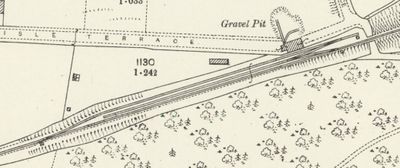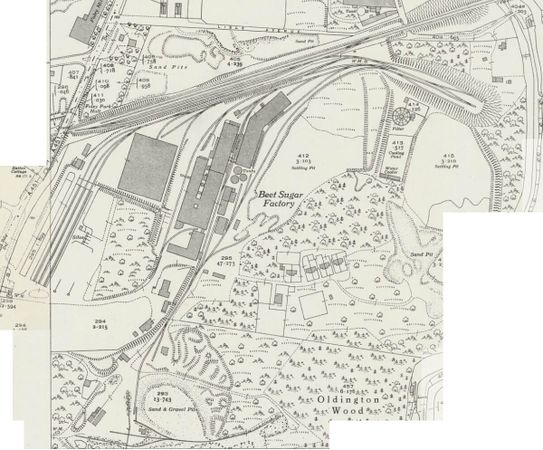Gravel Pit at Foley Park

A short-lived Gravel pit at Foley Park was served by its own private siding in the early 1900s.
In December 1900, Kidderminster Town Council agreed to supply Kellett & Sons of Victoria Street, London, with water at their works at Foley Park at 9d per 1000 gallons for an estimated period of two years for the purpose of washing gravel in connection with the 'Birmingham water scheme'.[1] [note 1]
On 12 November 1901, Major I.W.Pringle made an inspection of the "new gravel siding (Kellett's)" at Foley Park on behalf of Lieut. Col. Yorke of the Board of Trade and noted that "The facing points are provided with a lock, but not with a bar, and are each worked from a ground frame containing two levers. The ground frames are released by the key on the electric train staff for the section.". The following day, he recommended the Board of Trade to authorise the new connection.[2]
The 1902 Ordnance Survey map of Foley Park (right) shows the gravel pit with its own loop and siding. The pit was situated at the end of Lisle Avenue (then named Lisle Terrace) close to the underbridge which can be seen on right of the map. The area south of the line was still undeveloped at that time.
A. Kellett & Sons of Foley Park Gravel Works went into liquidation and the plant and machinery was sold at auction in June 1904. At around the same time, Kellet's plant and machinery at Frankley Reservoir, Birmingham, was also auctioned.[3] By the next revision of the map in 1926, the gravel siding north of the line had been removed and the area formerly occupied by the gravel pit had become part of the Empire Carpet Works buildings. Construction of the British Sugar Corporation's factory and its Foley Park sidings south of the line had also been completed, with the ground frame at the east end of those sidings being in the same location as that formerly serving the gravel sidings. The new layout can be seen at the top of this 1938 map.
-
1938 OS Map
See also[edit | edit source]
References[edit | edit source]
Notes[edit | edit source]
- ↑ The 'Birmingham water scheme' was the 73 mile pipeline and associated works carrying water from the Elan Valley in central Wales to Frankley Reservoir in Birmingham, built between 1896 and 1906. The pipeline is visible from the train where it crosses the River Severn between Bewdley and Arley via the Elan Valley Aqueduct.
